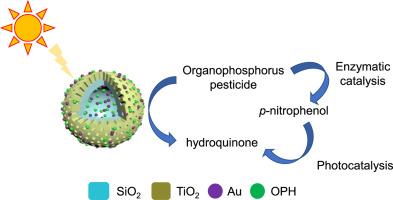The worldwide application of organophosphorus pesticides (OPs) has promoted agricultural development, but their gradual accumulation in soil and water can seriously affect the central nervous system of humans and other mammals. Organophosphorus hydrolase (OPH) is an effective enzyme that can catalyze the degradation of the residual OPs. However, the degradation products such as p-nitrophenol (p-NP) is still toxic. Thus, it is of great significance to develop a multi-functional support that can be simultaneously used for the immobilization of OPH and the further degradation of p-NP. Herein, a visible light assisted enzyme-photocatalytic integrated catalyst was constructed by immobilizing OPH on hollow structured Au-TiO2 (named OPH@H-Au-TiO2) for the degradation of OPs. The obtained OPH@H-Au-TiO2 can degrade methyl parathion to p-NP by OPH and then degrade p-NP to hydroquinone with low toxicity by using H-Au-TiO2 under visible light. OPH molecules were immobilized on H-Au-TiO2 through adsorption method to prepare OPH@H-Au-TiO2. After 2.5 h of reaction, methyl parathion is completely degraded, and about 82.64% of the generated p-NP is further degraded into hydroquinone. After reused for 4 times, the OPH@H-Au-TiO2 retains more than 80% of the initial degradation activity. This research presents a new insight in designing and constructing multi-functional biocatalyst, which greatly expands the application scenarios and industrial value of enzyme catalysis.



